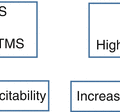Fig. 44.1
Arm crank ergometer
Resistance exercise training has also been suggested as an effective training modality [19–23]. Indeed, LLPAD patients have a significant reduction in calf muscle area [24] and also have lower leg strength which is associated with walking capabilities [22]. It has been demonstrated that 12-week whole-body (e.g., calf raise on leg press machine, leg press, leg curl, leg extension, crunches, seated row, bench press) resistance training [3 sets of 10 repetitions performed at the intensity between 11 and 13 (light and somewhat hard, respectively) on Borg’s scale (rating of perceived exertion to monitor level of intensity during exercise)] improves walking performance to a similar extent as treadmill exercise training [21]. Interestingly, compared to walking, this mode of exercise elicits lower pain during the training sessions [23]. Furthermore, longer resistance training programs have also been evaluated. It has been shown that 24-week whole-body resistance training [2 sets of 8–15 repetitions performed at approximately 70% of one repetition maximum (1RM)] significantly improves walking performance and strength compared to control group [20]. Another study [19] showed that 24-week lower limb progressive resistance training (3 sets of 8 repetitions performed at 50–80% 1RM) improves walking performance on treadmill and quality of life (assessed by questionnaire) compared to control group. However, there were no significant changes in the 6MWD compared to control group [19]. Finally, it has recently been demonstrated that intensity of resistance training may also have an impact on the improvement of walking performance. Indeed, 24-week whole-body high-intensity progressive resistance training (3 sets of 8 repetitions performed at 50–80% 1RM) significantly improved the 6MWD and whole-body strength compared to whole-body low-intensity resistance training (3 sets of 8 repetitions performed at 20–30% 1RM) and control group. The adaptations in the high-intensity progressive resistance training group were related to significant changes in bilateral calf and hip extensor skeletal muscle endurance [22].
Nordic pole walking has been shown to increase the PFWD and the MWD compared to walking without poles, suggesting that this type of exercise may improve walking performance despite a higher cardiovascular stimulation [25]. The use of poles may increase the walking speed and reduce the lower extremity load, which seems to be relevant in LLPAD patients [26]. In addition, as elderly LLPAD patients may have an impaired balance [27], the use of poles might also be useful. It has been demonstrated that 24-week Nordic pole walking exercise training, performed at maximal or near to maximal claudication pain, increases walking performance, V′O2peak, and physical functioning (assessed by questionnaire) in LLPAD patients [28]. Nordic pole walking training was found to be as effective as treadmill training for the improvement in walking performance [29].
Cycling exercise might also be a safe and feasible training modality [30]. Although 6-week cycling exercise training performed at vigorous intensity showed a significant increase in cycling time, no significant improvement was observed in walking performance in response to cycling exercise compared to treadmill exercise training (performed at the same relative exercise intensity) in LLPAD patients [30]. However, in a subgroup of patients who experienced similar (anatomic location) exercise-limiting symptoms during walking and cycling, walking performance was improved after cycling training. This suggests a cross-transfer effect of training modalities and highlights the potential role of cycling in some LLPAD patients [30].
In conclusion, data suggest that different training modalities (other than walking) are safe, feasible, and effective in LLPAD patients. These allow elderly LLPAD patients to benefit from rehabilitation programs taking into account their specific needs. Compared to walking, the lower pain induced by other training modalities during exercise may encourage patients to better adhere to regular exercise training. To better optimize training prescription in all LLPAD patients, further research is needed using combined or varied training modalities.
Key Points
Regular exercise training is recommended as one of the primary baseline measures in LLPAD patients.
Other than walking, different training modalities (e.g., arm crank ergometer, resistance training, Nordic pole walking, and cycling) are safe, feasible, and effective in LLPAD patients.
References
1.
Lane R, Ellis B, Watson L, Leng GC (2014) Exercise for intermittent claudication. Cochrane Database Syst Rev 7:CD000990
2.
3.
4.
5.
McDermott MM, Liu K, Greenland P, Guralnik JM, Criqui MH, Chan C et al (2004) Functional decline in peripheral arterial disease: associations with the ankle brachial index and leg symptoms. JAMA 292:453–461CrossrefPubMed
Stay updated, free articles. Join our Telegram channel

Full access? Get Clinical Tree





